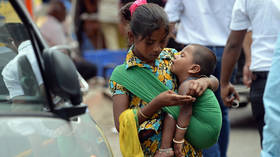UN lauds India for lifting 415 million citizens out of poverty in 15 years

India has succeeded in bringing 415 million people out of poverty in the past 15 years, according to a new report released by the UN. It comes months after the country surpassed China to become the world’s most populous nation with more than 1.42 billion people.
The latest Multidimensional Poverty Index (MPI) update, produced by the United Nations Development Program (UNDP) and the Oxford Poverty and Human Development Initiative (OPHI), shows that multidimensional poverty in India fell from 55.1% in 2005-06 to 16.4% in 2019-21. The MPI is based on ten critical parameters, including healthcare, education and standard of living.
“India has shown great commitment and leadership in lifting people out of poverty, especially among the poorest in the country,” said Shoko Noda, the resident representative of UNDP India. “The Sustainable Development Goal (SDG) target 1.2 is for countries to reduce at least by half the proportion of men, women, and children of all ages living in poverty in all its dimensions by 2030. India’s progress shows that this goal is feasible, even at scale.”
The UN praised India’s progress, which has seen it outperform countries worldwide and significantly contribute to an appreciable dip in poverty in South Asia. For the first time, the region is behind Sub-Saharan Africa in terms of poor population (385 million in South Asia compared to 579 million in Sub-Saharan Africa).
India is among 25 countries that have successfully halved their global MPI values within 15 years, the UNDP noted. The findings revealed that rural areas were the poorest and had seen the fastest reduction, while children were the poorest age group. Similarly, the poorest caste and religious groups in the country reported the fastest improvements between 2015-16 and 2019-21. For instance, Bihar, the poorest state in eastern India, saw the fastest reduction in MPI values in absolute terms. The incidence of poverty in Bihar fell from 77.4% in 2005-06 to 52.4% in 2015-16, and 34.7% in 2019-21.
The report revealed, however, that India is still home to the largest number of poor people in the world at 228.9 million, including 97 million children. The government is facing the daunting prospect of aiming to eradicate poverty amid the country’s growing wealth gap. It is notable that the MPI figures were collected before the Covid-19 pandemic, so the effects of this and the associated economic shocks in India cannot be assessed yet.
The report highlighted the role of integrated interventions by state authorities to improve the lives of millions of poor people in India. Prime Minister Narendra Modi has launched a raft of welfare schemes since he came to power in 2014, assisting in areas such as affordable housing, sanitation and cooking fuel, in a bid to alleviate poverty. “With its focus on sustainable livelihoods, strengthening institutions, upskilling of women and young people, increased access to services for vulnerable communities, and a just transition to clean energy, UNDP is complementing India’s effort towards eradicating poverty and reducing inequalities,” Noda added.












